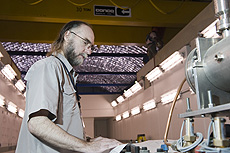Historical Fermilab-developed software still in use
 |
Twenty years ago, Fermilab scientist Peter Kasper, pictured, and the Computing Sector's Ruth Pordes developed a Unix code management system free to the public. Members of the scientific community make use of it to this day. Photo: Reidar Hahn |
Every once in a while, something prompts you to take a walk down memory lane. For Peter Kasper, Fermilab physicist, and Ruth Pordes, associate head of the Computing Sector, that something was an email they received last month about software made publicly available more than 20 years ago.
"It makes you wonder how much of an impact this has had," Kasper said of the software. "This guy didn't contact us because it was broken. He was just dotting his i's and crossing his t's."
Back in the 1990s, before experiments at Fermilab had names, and in the very early days of the Internet, Fermilab was transitioning from using VAX computers and operating systems to using machines that ran Unix. The new machines did not have a system for managing code as good as the VAX machines, so Kasper designed a system for Unix using the same concepts.
Pordes and Kasper realized that others must be having similar problems and released the Unix code management system, or UCM, through FermiTools, an umbrella website that provided software developed at the laboratory free to the public.
They heard nothing of UCM during the last couple of decades until they received John Boia's email inquiring about a newer version. Boia, who works for the Space Telescope Science Institute (STScI), the organization that serves as Hubble Space Telescope's operations center, was updating the organization's systems and wanted to update their UCM.
"As new systems came in, it just kept on working because it was so vanilla," Kasper said of the generic code used to create UCM. "These guys picked it up and have been using it for more than a decade, completely unbeknownst to us."
STScI uses UCM as the basis for several systems that govern the routine observations, maneuvers and other housekeeping items for the Hubble Space Telescope and the James Webb Space Telescope, Hubble's successor, scheduled for launch in 2018. They found that UCM was a suitable replacement for the VAX code management system when they moved on to other operating systems.
There was a newer version of UCM from what STScI was using, one that Pordes was able to provide. That newer version was also produced nearly 20 years ago.
"I really like that individuals at the laboratory are developing these useful tools and that there are users out there who continue to find them useful after all of these years," Pordes said. "This is a real testimony to the quality of our work and to the way Fermilab's outreach efforts continue to benefit the public."
—Rhianna Wisniewski
|